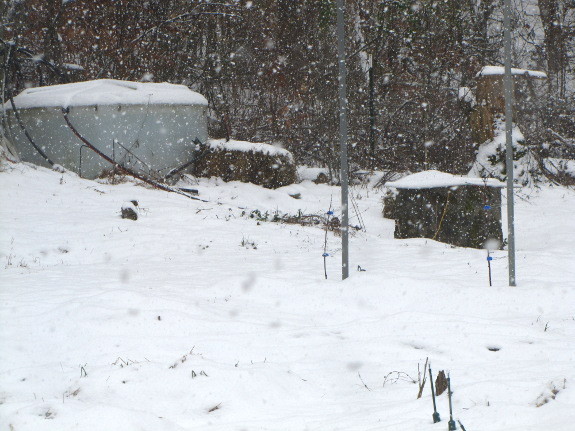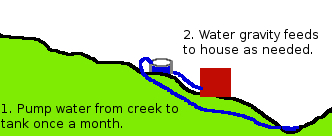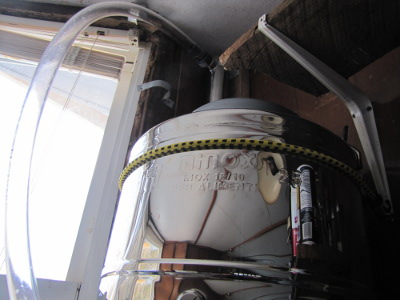
Two water systems

Mark's a big fan of
backups, and our dual water system is a good example of why his
methodology is perfect for the farm. As I've written previously,
we have two water systems --- one for potable (drinking) water and one
for nonpotable water.
 The
nonpotable
water system involves pumping water from the creek to a 1,000
gallon tank. The creek drains a large watershed, so the water is
only moderately pure, meaning it's only good for washing and
irrigation. But there's a lot of it, and once we fill the tank,
water gravity-feeds to the house with no need for electricity for about
a month. That means during power outage situations, we still have
a lot of semi-pure water with little effort that we can use for washing
hands, dishes (with a bit of bleach), and clothes. On the
negative side, though, we haven't quite got this waterline to the point
where it doesn't freeze when lows drop into the mid-teens, although
water does start flowing again pretty quickly once temperatures rise
above freezing. So we spend what amounts to perhaps five full
days a year with the nonpotable water inaccessible due to cold weather.
The
nonpotable
water system involves pumping water from the creek to a 1,000
gallon tank. The creek drains a large watershed, so the water is
only moderately pure, meaning it's only good for washing and
irrigation. But there's a lot of it, and once we fill the tank,
water gravity-feeds to the house with no need for electricity for about
a month. That means during power outage situations, we still have
a lot of semi-pure water with little effort that we can use for washing
hands, dishes (with a bit of bleach), and clothes. On the
negative side, though, we haven't quite got this waterline to the point
where it doesn't freeze when lows drop into the mid-teens, although
water does start flowing again pretty quickly once temperatures rise
above freezing. So we spend what amounts to perhaps five full
days a year with the nonpotable water inaccessible due to cold weather.
 Our
potable water supply is pumped up out of a shallow well (which looks
like a dark box in the photo at the top of this post), then is piped
through a sediment
filter and a UV light,
before ending up in the new,
larger reservoir
Mark recently installed in our kitchen. The main benefit of the
well is that we own its entire (small) watershed and the land is
completely wooded, so our well water is almost certainly free of
pesticides and herbicides. There's much less of the well water,
though, and it seems wasteful to run water through the UV light
(requiring electricity) and a sediment filter (that has to be changed
every few months) for uses other than washing and cooking. On the
other hand, the line never freezes, so as long as we have power, we
have water of some sort.
Our
potable water supply is pumped up out of a shallow well (which looks
like a dark box in the photo at the top of this post), then is piped
through a sediment
filter and a UV light,
before ending up in the new,
larger reservoir
Mark recently installed in our kitchen. The main benefit of the
well is that we own its entire (small) watershed and the land is
completely wooded, so our well water is almost certainly free of
pesticides and herbicides. There's much less of the well water,
though, and it seems wasteful to run water through the UV light
(requiring electricity) and a sediment filter (that has to be changed
every few months) for uses other than washing and cooking. On the
other hand, the line never freezes, so as long as we have power, we
have water of some sort.
Having two systems means
we probably spend twice as long fixing things that inevitably go wrong,
and it definitely cost more to set up than a single system would
have. But it's nice knowing that our water supply is completely
under our own control, and I suspect we end up paying less than
neighbors on city water even in a climate where water is
plentiful. There are several other options that could have worked
as well --- collecting rainwater off the roof, using different kinds of
filters --- but this system seems to suit our farm very well.
Want more in-depth information? Browse through our books.
Or explore more posts by date or by subject.
About us: Anna Hess and Mark Hamilton spent over a decade living self-sufficiently in the mountains of Virginia before moving north to start over from scratch in the foothills of Ohio. They've experimented with permaculture, no-till gardening, trailersteading, home-based microbusinesses and much more, writing about their adventures in both blogs and books.
Want to be notified when new comments are posted on this page? Click on the RSS button after you add a comment to subscribe to the comment feed, or simply check the box beside "email replies to me" while writing your comment.

Do you own a TDS meter? It would be interesting to see the PPM of the different water systems. While the information is not detailed it would at least offer something as the effectiveness of each filtering setup. My own experience is that anything short of a full on RO $75+ RO system or $150 electric distiller is not effective in reducing PPM.
Our best water comes from our roof.
We own a small 2.36 acre homestead in the middle of farming country. We are literally at the edge of the prairie. If you look west you can see for miles and miles, but if you look east it's a wooded creek bottom with deep hills and valleys. Our property has a hand dug well the circumference of a wagon wheel and lined in stone and brick that is ~30' deep by our measurement. We took a reel tape measure and tied a large nut to the end and dropped it in. We dropped several times in different spots to make sure we weren't hitting some foreign object that might have been put in there. Each measurement read within a few inches of being the same.
Our house was connected to rural water when we bought it. We would love to be able to reconnect with the well, but are unsure that a 30' deep well is enough to keep us in water. It is also almost ceratinly contaminated with pesticides since we are surrounded by crop land. To complicate matters the well is across the driveway from the house.
Do you have any comments or advise?
Mikey --- We don't have a TDS meter --- I just look at the difference in turbidity by eye. Our sediment filter definitely reduces levels, but probably not really enough to get full effectiveness from the UV light. We haven't gotten sick, though, and the hand-dug well definitely has coliform bacteria in it, so something must be working....
Michelle --- That sounds very much like our shallow well, except for the problems in the watershed. I wonder if you wouldn't be better off catching rain from your roof in your situation? Shallow wells are okay, but in my opinion they tip over into not-so-good if you can't control their entire watershed.
a) Now I see your need for UV tx, having a shallow well. "Natural filtration" thru the soil is fairly good, but contamination with surface run-off is more likely, so frequent testing is probably wise, even with the UV set-up.
b)Are you familiar with the gravity powered ramjet water pump? http://www.youtube.com/watch?v=u2nGlnMNXrw You could avoid the need for an electric pump with this system. There's plenty of building instructions on-line. It looks pretty easy.